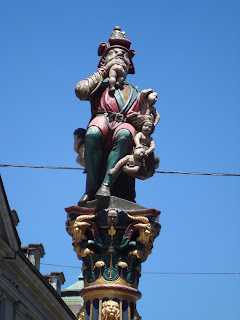Over the 4th of July weekend, I was lucky enough to go visit a close family friend (my "Aunt" Diane) in Firenze (Florence), Italy! Firenze is honestly one of the most beautiful places that I've ever seen, and Aunt Diane was a great hostess!
On Friday, Diane took me on an "insider's" walking tour of Firenze. We passed all of the famous sites - the museums, the piazzas, the Duomo and took the obligatory tourist photos (Diane helped with quite a few of them which explains why this post has significantly better pictures than my other blog posts). She told me about the city's history and architecture, and then about Italian politics, education, and health care, living in Firenze, etc. She did note that the tourists now flock to the city in overwhelming numbers and complicate life for the residents. The lines at all the main sites were very long, so we didn't go inside many of them, but we checked out a few that were less well known on the outskirts of the city. Also, we made sure to stop at Mercato Nuovo (the former straw market) so that I could rub the nose of Il Porcellino ("The Piglet"). Florentine tradition holds that anyone who rubs the statue's nose will return to the city, so hopefully, I'll be back someday!
That afternoon, Diane's friend Irma and I got gelato and then drove up into the hills overlooking the city. We checked out some neighboring towns, churches, and the most expensive Florentine hotel. The views were breathtaking, and there are really no other words to explain them. Irma taught me about the Etruscan civilization that used to live in the hills and then the beginning of Firenze (land was originally given to retired Roman veterans) along with the Italian language.
That night, we went out to dinner with Paola, a friend who doesn't speak much English. I had taken one Italian lesson before my trip to Firenze, and so my skills at that point were very limited. (Luckily, I spent most of the time with Aunt Diane and Irma, who both work as Italian-English translators.) At dinner, Paola decided to order the Pizza "Regina" (Italian for queen, just in case you didn't know), and I laughed and reminded Diane that that's my full name (she calls me "Gina"). Diane started to say that to Irma who said, "She's Gina," and after some confusion I remembered the only Italian sentence I had learned at that point. I cried, "Mi chiamo (My name is) Regina!" and Paola actually understood me. I was proud that I knew how to say something. Afterward, dinner on the terrace next to the Arno River was excellent!
On Saturday morning, Diane, Irma, and I visited Diane's brother Mark on the set of the movie that he's filming. He's currently the Director of Photography for an Italian comedy. It's scheduled to come out in November, and I'm looking into getting a copy with English subtitles. The location was a beautiful park (see the photo - the structure is normally part of the park, it wasn't constructed for the film). That afternoon, Diane and I went to visit her friends Carla and Andrea who live in the "country." Their house (and surrounding olive groves and vineyard) is literally a 15 minute drive from Diane's apartment. The atmosphere there was so tranquil compared to the busy city, and it was quite a nice escape. Andrea showed us around the vineyard and the olive groves and served us homemade, solar-brewed green tea. He explained about farming, taught me about tree grafting, and gave us apricots and plums right off the trees. Diane told me that she and her friends all like to help out with the farming (especially the olive harvest) to have a group activity and to (pardon my pun) enjoy the fruit of their labor. Andrea and Carla were both so friendly and welcoming, it was easy to understand why their house is a popular gathering spot. Finally, Saturday ended with a delicious Italian dinner at Mark's apartment.
That afternoon, Diane and I went to visit her friends Carla and Andrea who live in the "country." Their house (and surrounding olive groves and vineyard) is literally a 15 minute drive from Diane's apartment. The atmosphere there was so tranquil compared to the busy city, and it was quite a nice escape. Andrea showed us around the vineyard and the olive groves and served us homemade, solar-brewed green tea. He explained about farming, taught me about tree grafting, and gave us apricots and plums right off the trees. Diane told me that she and her friends all like to help out with the farming (especially the olive harvest) to have a group activity and to (pardon my pun) enjoy the fruit of their labor. Andrea and Carla were both so friendly and welcoming, it was easy to understand why their house is a popular gathering spot. Finally, Saturday ended with a delicious Italian dinner at Mark's apartment.






















